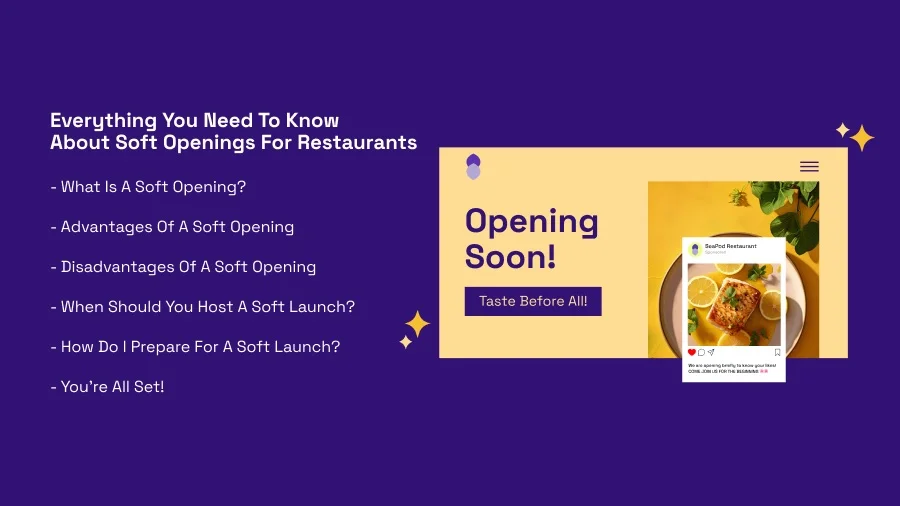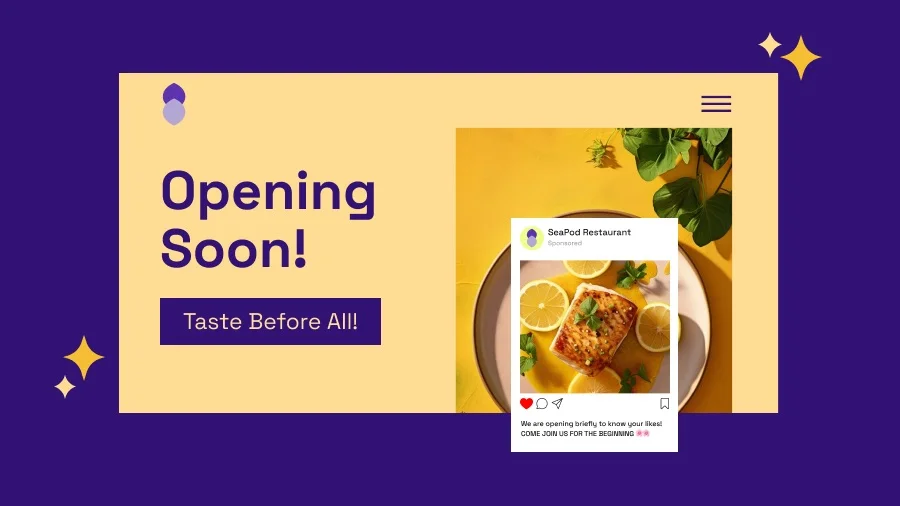Everything You Need to Know About Soft Openings for Restaurants
Having purchased a location, hired staff, and designed a menu, the only thing left is to open the doors.
Where do you begin?
Soft openings are a great way to test out and tweak your processes before throwing the doors open to the public, regardless of whether you want a local buzz around your restaurant opening.
We've got everything you need to know for a successful soft opening for your restaurant.

What exactly is a restaurant soft opening? A soft opening is when you start your restaurant for a small group of people before officially opening your doors to the public. Consider it a practice period comprised of invite-only days or a series of events aimed at testing your operations and creating some marketing buzz before the big launch.
During this time, you may only operate for a few hours per day or with a limited menu. And you might not have your entire team on hand yet. A soft opening often lasts a few days to a few weeks, depending on how long it takes to incorporate all of the feedback and iron out any last-minute kinks.
Advantages of a Soft Opening
A soft opening is not required, but there are clear benefits to hosting one before fully opening your doors. The following are some of the key benefits:
- Get feedback: Collect feedback from consumers on the cuisine, drinks, service, and overall atmosphere.
- Work out your location's logistics: Examine the seating capacity, the flow of the room, the point-of-sale system, and the kitchen equipment.
- Prepare the team: Allow staff to practice menu knowledge and learn how to be a good server, resulting in consistency among staff members.
- Create excitement: Spread the word about your new location by encouraging guests to tell their friends about their experience.
- Make changes: Before opening, take into account the feedback and make any adjustments that are needed before opening.
Disadvantages of a Soft Opening
It is important to note that there are certain disadvantages to hosting a soft opening:
- Creates a sense of urgency to open: A soft opening should be held with a grand opening date in mind. That date should not be too far after the soft launch, or else the excitement will fade, and your customers may forget or lose interest.
- Exposes ideas to competitors: A soft launch exposes your ideas to the world, which could end up in the hands of a competitor. If you postpone your grand opening for too long, they may be able to execute those ideas before you do.
- Low-quality feedback: Hosting a friend and family restaurant's soft opening may not give you the best feedback. Those closest to you may wish to spare your feelings when it comes to criticism, so encourage them to be upfront and honest with constructive feedback or invite more guests outside of your circle.
When Should You Host a Soft Launch?
In most cases, your soft launch date is chosen with your opening date in mind. You want to avoid a big gap between your soft and grand openings because the hype quickly dies down after the soft opening. A few days to a week is a reasonable window of time.
In this manner, if any significant findings come from the soft opening, you will have sufficient time to act on them.

How Do I Prepare for a Soft Launch?
Because no two restaurants are the same, there is no one-size-fits-all strategy for planning and executing a soft launch.
However, there are some common factors that all restaurant must focus on in order to prepare for the soft launch, such as menu, pricing, time frame, and guests.
Consider making a rough timeline for execution as you progress through this part to assist you stay on track. For example, design your menu six weeks in advance and send out invitations four weeks before the soft launch.
1) Plan Your Menu
Answering the following five questions is a fantastic place to begin your meal planning:
- Will there be a full menu or a limited menu?
- Will we serve our menu over multiple days?
- What can we offer?
- How many portions will we make?
- What are our specialty dishes?
During this planning step, you can pick between a full or limited menu.
(I) Limited Menu:
Most people understand that a soft launch is just a dress rehearsal for the official launch, so they're fine with a lesser menu.
With a smaller menu, you can focus on offering an excellent experience for that group as opposed to an average one for many. The more food you have to prepare and serve, the more likely it is that you will make mistakes in both the kitchen and the front of the house.
This does imply that you must carefully select your food, perfect it, and provide excellent customer service.
Whatever you select, make it clear to your consumers that this is a test menu.
(II) Full Menu:
Offering a full menu is usual for many restaurants that choose to have their soft opening close to the official launch. Although this strategy can help you get started quickly, it is not without drawbacks.
For starters, there are more elements to manage, which leads to stress and errors. Second, when you're attempting to do so much, it's easy to create an average eating experience. Last but not least, testing so many factors makes it difficult to pinpoint problems.
Check out our latest blog on making restaurant menus from scratch.
2. Choose a Time Frame
Your soft opening can be one big event, or several smaller ones spread out over a few days or several weeks.
The length of your soft launch, on the other hand, will be determined by a variety of things, such as your budget and opening timeframes. In general, the smaller your budget, the shorter your soft launch.
3. Select Your Pricing Strategy
It's time to price your menu items after you've prepared your menu and determined a time frame. These are the three choices:
- Free: This is your most expensive option, but it increases client loyalty. With this option, your employees are likely to receive tips, therefore you'll have to pay them more than usual. Consider this pricing option if you only have one big event, because it can get expensive if you serve free food multiple times.
- Full Price: Although this is the least expensive option for you, it will not attract new customers to your venue. On the bright side, it tells customers exactly how much they can expect to pay from the start, avoiding surprises later. If you intend to charge full money, provide some freebies to thank guests for their support.
- Discounted: Discounted pricing is a wonderful middle ground between free and full price that divides the cost between you and the customer. It's an excellent approach to building goodwill and obtaining customer feedback without breaking the bank.
4. Creating a Soft Opening Guest List
You may be tempted to open your doors to the public straight away for your soft launch. However, who you invite can have a strong impact on you on your success moving forward.
(I) Invite People You Know
Friends and family are far more forgiving in the event of hiccups during your soft opening. A throng of familiar folks will offer constructive criticism and insight while being conscious that this is a test run. Simply remind them to be truthful, as friends and family are more inclined to spare your feelings.
It's easier to follow up with people you know if you invite them. This allows you to examine your strengths and weaknesses and make those final tweaks before opening it to the public. Familiar folks are also more likely to contribute free advertising and help build anticipation before you officially open.
(II) Contact Local Business Owners
Many restaurant owners may throw a soft opening event just for the neighboring companies in their neighborhood to introduce themselves to local business owners. A soft opening is typically a restaurant's first introduction to the local community, making it a great chance to make a positive first impression with other local business owners.
By throwing a lunch or happy hour exclusively for local businesses, you're expressing you want to contribute to the existing community you've joined. This may result in some bookings for upcoming events and dinner times. Developing professional ties with other community businesses is vital for your success, so make a strong first impression.
(III) Reach out to Community Leaders and Influencers
Invite prominent local leaders and community influencers to a restaurant soft opening. These people have a lot of clout in the community, which means they can generate great word-of-mouth advertising.
Community leaders and influencers often have following that other members of the community do not have. Positive feedback from these influential people can boost your restaurant's reputation and give your business a jump start. Just be prepared to go to great lengths to impress these people, as their words carry a lot of weight and negative feedback from them might cause more harm than good.
From influencers to relatives, here's what to put in your invitations:
- The address, time, and date
- The Dress code
- Menu pricing
- Where to RSVP
Ensure that attendees have adequate time to prepare for the event and so that participation is high. If you send a late notice, you can find that many of your guests already have other plans. Send out invitations four weeks before the soft launch.
You're All Set!
When you have the menu planned, the pricing set, the invitations mailed, and the final prep done, it is time for the soft launch. Now you just need to execute on the day.
Remember that the primary goal of a soft launch is to test specific elements and fix problems.
Make sure you have a strategy in place for collecting constructive feedback from guests on the big day. At the end of the evening, hand out a questionnaire or hold an informal chat where you ask for feedback.
Either way, be sure to get the feedback as soon as possible after the event so you can use it for your grand opening!
Hosting a soft launch has numerous advantages for your restaurant. A soft opening not only helps you generate anticipation before the grand opening, but it also offers your team a practice run and allows you to identify challenges. Then it's simply a few minor tweaks to achieve a successful grand opening!
Of course, you must first prepare to reap these rewards. This entails a laser focus on key elements such as your menu, pricing strategy, and guest list. Concentrate on those, and you'll be one step closer to a successful soft launch.
KEY TAKEAWAY !

